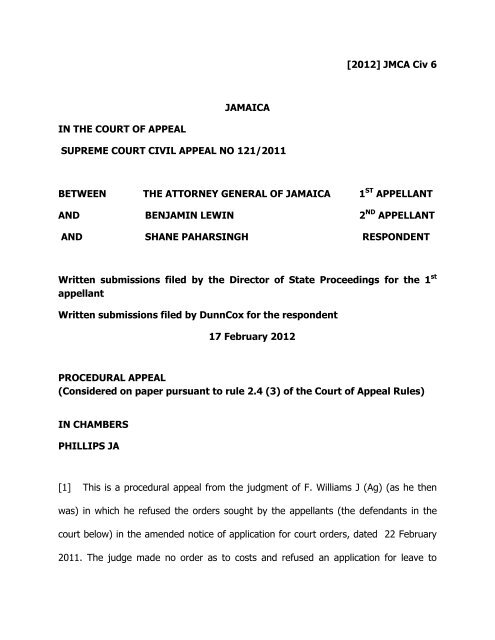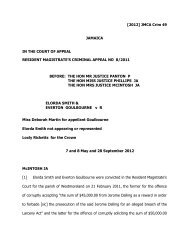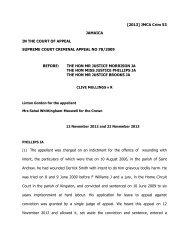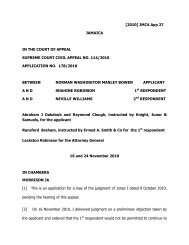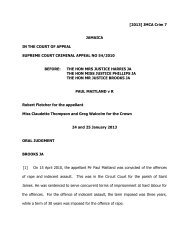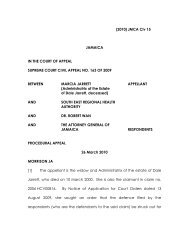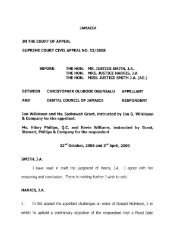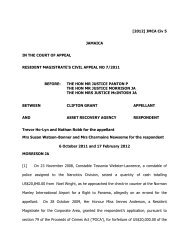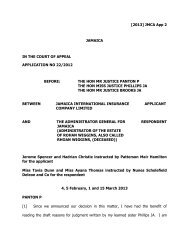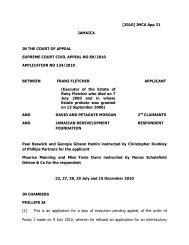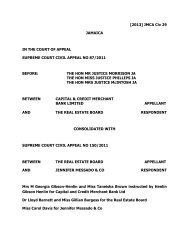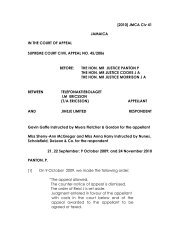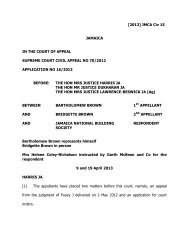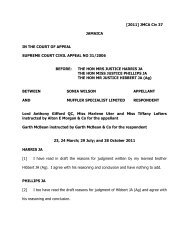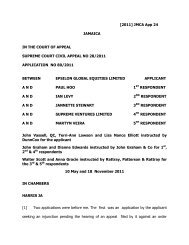Attorney General of Jamaica (The) & Anor v Paharsingh (Shane).pdf
Attorney General of Jamaica (The) & Anor v Paharsingh (Shane).pdf
Attorney General of Jamaica (The) & Anor v Paharsingh (Shane).pdf
- No tags were found...
Create successful ePaper yourself
Turn your PDF publications into a flip-book with our unique Google optimized e-Paper software.
[2012] JMCA Civ 6<br />
JAMAICA<br />
IN THE COURT OF APPEAL<br />
SUPREME COURT CIVIL APPEAL NO 121/2011<br />
BETWEEN THE ATTORNEY GENERAL OF JAMAICA 1 ST APPELLANT<br />
AND BENJAMIN LEWIN 2 ND APPELLANT<br />
AND SHANE PAHARSINGH RESPONDENT<br />
Written submissions filed by the Director <strong>of</strong> State Proceedings for the 1 st<br />
appellant<br />
Written submissions filed by DunnCox for the respondent<br />
17 February 2012<br />
PROCEDURAL APPEAL<br />
(Considered on paper pursuant to rule 2.4 (3) <strong>of</strong> the Court <strong>of</strong> Appeal Rules)<br />
IN CHAMBERS<br />
PHILLIPS JA<br />
[1] This is a procedural appeal from the judgment <strong>of</strong> F. Williams J (Ag) (as he then<br />
was) in which he refused the orders sought by the appellants (the defendants in the<br />
court below) in the amended notice <strong>of</strong> application for court orders, dated 22 February<br />
2011. <strong>The</strong> judge made no order as to costs and refused an application for leave to
appeal from, and for a stay <strong>of</strong> execution <strong>of</strong> his judgment. <strong>The</strong> application before<br />
Williams J (Ag) had asked for: a declaration that the claim (CL1991/P-041) had been<br />
struck out since 1 January 2004, pursuant to rule 73.3(8) <strong>of</strong> the Civil Procedure Rules<br />
2002 (CPR); an order that the assessment <strong>of</strong> damages hearing, which on 24 November<br />
2010 had been scheduled for 7 April 2011 was null and void, and consequently, the said<br />
date should have been vacated; costs; and such other relief as the court deemed just in<br />
the circumstances. Regrettably, however, the learned judge has not provided any<br />
reasons for his decision.<br />
[2] On 4 October 2011 a single judge <strong>of</strong> the Court <strong>of</strong> Appeal directed that the<br />
application for permission to appeal be heard by the full court. This was done, and on 4<br />
November 2011 the court granted leave to appeal the decision <strong>of</strong> F. Williams J and<br />
ordered a stay <strong>of</strong> execution <strong>of</strong> the decision and the proceedings in the Supreme Court<br />
pending the hearing <strong>of</strong> the appeal. On 4 November 2011, notice <strong>of</strong> appeal was filed<br />
herein.<br />
[3] This appeal concerns the interpretation and application <strong>of</strong> certain transitional<br />
provisions <strong>of</strong> the CPR. Bearing in mind that the CPR came into effect on 1 January<br />
2003, it is unusual for the transitional provisions <strong>of</strong> the CPR to still be the subject <strong>of</strong><br />
controversy and debate. In this case, the issue relates to whether two items <strong>of</strong><br />
correspondence written in 2003, when read together, could amount to a request for a<br />
case management conference, thereby avoiding the draconian consequences <strong>of</strong> failing<br />
to do so, as set out in the said provisions.
[4] Rule 73.3 <strong>of</strong> the CPR states as follows:<br />
“73.3 1. <strong>The</strong>se Rules do not apply to any old proceedings in<br />
which a trial date has been fixed to take place<br />
within the first term after the commencement date<br />
unless that date is adjourned and a judge shall fix<br />
the date.<br />
2. Where any old proceeding has been adjourned part<br />
heard, the trial judge may give directions as to the<br />
future conduct <strong>of</strong> the proceedings or direct that a<br />
pre-trial review is fixed.<br />
3. Where in any old proceedings an application is<br />
made to adjourn a trial date, the hearing <strong>of</strong> the<br />
application is to be treated as a pre-trial review<br />
and these Rules apply from the date that such<br />
application is heard.<br />
4. Where in any old proceedings a trial date has not<br />
been fixed to take place within the first term after<br />
the commencement date, it is the duty <strong>of</strong> the<br />
claimant to apply for a case management<br />
conference to be fixed.<br />
5. A defendant has a duty to apply for a case<br />
management conference if he has an ancillary<br />
claim under Part 18.<br />
6. When an application under paragraph (4) is<br />
received, the registry must fix a date, time and<br />
place for a case management conference under<br />
Part 27 and the claimant must give all parties at<br />
least 28 days notice <strong>of</strong> the date, time and place<br />
fixed for the case management conference.<br />
7. <strong>The</strong>se Rules apply to old proceedings from the<br />
date that notice <strong>of</strong> the case management<br />
conference is given.
8. Where no application for a case management<br />
conference to be fixed is made by 31 st December<br />
2003 the proceedings (including any counterclaim,<br />
third party or similar proceedings) are struck out<br />
without the need for an application by any party.<br />
9. A striking out pursuant to rule 73.3 (8) will be<br />
without prejudice to the defendants [sic] ability to<br />
claim costs.”<br />
[5] <strong>The</strong>re have been several authorities dealing with actions which commenced<br />
before the CPR came into effect (January 2003), and addressing how the transitional<br />
provisions set out in the CPR were to be applied, such as : Norma McNaughty v<br />
Clifton Wright and Ors SCCA No. 20/2005 delivered 25 May 2005, the initial<br />
beacon, followed by Dudley Burgess v Exton Wynter CL B 055/1997, delivered 26<br />
January 2006; Ian Wright and Others v Workers Savings & Loan Bank SCCA<br />
No. 26/2006, delivered 2 June 2006, and Holiday Inn <strong>Jamaica</strong> Inc. v Carl<br />
Barrington Brown SCCA No. 83/2008, delivered 19 December 2008. <strong>The</strong> principles<br />
which can be extracted from these cases I would summarize in this way:<br />
1. Proceedings commenced before 1 January 2003 were “old proceedings”.<br />
2. <strong>The</strong>re were two groups <strong>of</strong> “old proceedings”: those in which trial dates<br />
had been fixed in the Hilary term 2003, and those in which no trial dates<br />
were in existence as <strong>of</strong> January 2003.<br />
3. <strong>The</strong> CPR did not apply to “old proceedings” in which a trial date had been<br />
fixed in the Hilary term 2003. If the trial was not heard, or was adjourned,<br />
then the matter was generally governed, thereafter, by the CPR.
4. It was the duty <strong>of</strong> the claimant to apply for a case management<br />
conference date to be fixed in “old proceedings” in which no trial date had<br />
been fixed in the Hilary term.<br />
5. If no date for the case management conference was fixed, the claim stood<br />
automatically struck out without any application having to be made to<br />
obtain that order.<br />
6. <strong>The</strong> defendant also had a duty to apply for a case management<br />
conference if he had an ancillary claim under Part 18. However, once<br />
there was an application for a case management conference from either a<br />
claimant or a defendant with an ancillary claim, there had to be a<br />
consideration <strong>of</strong> the whole case. Neither party could apply for the case<br />
management conference limited to his own claim.<br />
7. Once the application for case management was received, the registrar had<br />
to fix a date, time and place for the same.<br />
8. <strong>The</strong> claim could be revived if struck out, if an application was made to do<br />
so by 1 April 2004, which application had to be served, but the court had<br />
no discretion to enlarge that time.<br />
9. Where a judgment existed in a claim as at 31 December 2003, rule 73<br />
could not and did not seek to strike out the claim. <strong>The</strong> judgment remained<br />
valid until set aside.<br />
10. Rule 16 makes provision for the case management conference after a<br />
default judgment is entered and before a hearing date for the assessment
<strong>of</strong> damages. <strong>The</strong>re is no requirement to apply for a case management<br />
conference if a default judgment has been entered.<br />
[6] <strong>The</strong> background and the chronology <strong>of</strong> events in this matter are set out below:<br />
1. <strong>The</strong> respondent commenced the action by way <strong>of</strong> a writ <strong>of</strong> summons<br />
dated 28 March 1991 and statement <strong>of</strong> claim dated 5 June 1992 for loss<br />
and damages suffered as a result <strong>of</strong> a collision with a government-owned<br />
motor truck on 17 July 1990. <strong>The</strong> initiating documents were duly served<br />
and the first defendant (the 1 st appellant) entered an appearance on 16<br />
April 1991.<br />
2. On 19 May 1994 a summons for leave to enter judgment was filed with<br />
supporting affidavit, and no defence having been filed, on 6 March 1995,<br />
the respondent was granted leave to enter judgment against the 1 st<br />
appellant in default <strong>of</strong> defence. On 20 March 1995, the order was served<br />
on the 1 st appellant.<br />
3. On 9 March 1995, an interlocutory judgment in default <strong>of</strong> defence was<br />
filed by the respondent and letters were written to the registry <strong>of</strong> the<br />
Supreme Court subsequent thereto requesting that judgment be entered<br />
against the 1 st appellant. A summons to proceed to assessment was also<br />
filed.
4. On 14 June 2000, an interlocutory judgment in default <strong>of</strong> defence and a<br />
summons to proceed to assessment <strong>of</strong> damages were filed yet again in<br />
the same terms as that previously filed in 1995.<br />
5. On or about 4 February 2000 the attorneys-at-law for the respondent<br />
were informed that the court’s registry had been unable to locate its file<br />
since around December 2001. <strong>The</strong> default judgments filed in 1995 and<br />
2000 had not been entered.<br />
6. On 17 and 23 January 2003 the respondent’s attorneys-at-law wrote to<br />
the registrar. <strong>The</strong>se letters are at the centre <strong>of</strong> this appeal, so for clarity, I<br />
have set out the letters, which are quite short, in their entirety.<br />
Letter <strong>of</strong> 17 January 2003:<br />
“January 17, 2003<br />
<strong>The</strong> Registrar<br />
Supreme Court<br />
King Street<br />
Kingston<br />
Dear Madam,<br />
Re: Suit No. C.L. P-041 <strong>of</strong> 1991<br />
<strong>Shane</strong> Paharasingh v <strong>Attorney</strong> <strong>General</strong> <strong>of</strong> <strong>Jamaica</strong><br />
and Benjamin Lewin
We refer to our letters dated 4 th February 2002 and 7 th<br />
March, 2002, copies <strong>of</strong> which are enclosed for ease <strong>of</strong><br />
reference.<br />
In order to assist with the entry <strong>of</strong> the Interlocutory<br />
Judgment in Default <strong>of</strong> Defence filed by us on behalf <strong>of</strong> the<br />
Plaintiff on 14 th June, 2000 and the fixing <strong>of</strong> a date for the<br />
hearing <strong>of</strong> our Summons to Proceed to Assessment <strong>of</strong><br />
Damages which was filed on the same date, we enclose<br />
herewith a copy <strong>of</strong> our file in relation to the captioned<br />
matter.<br />
We trust that you will find this to be <strong>of</strong> assistance.<br />
Yours faithfully,<br />
DUNNCOX<br />
Per:<br />
STACEY ANN L. POWELL<br />
Encls./ ”<br />
Letter <strong>of</strong> 23 December 2003:<br />
“December 23, 2003<br />
<strong>The</strong> Registrar<br />
Supreme Court<br />
King Street<br />
Kingston<br />
ATTENTION: MRS. LINDO<br />
Dear Madam:<br />
Re: Suit No. C.L. P-041 <strong>of</strong> 1991<br />
<strong>Shane</strong> Paharasingh v <strong>Attorney</strong> <strong>General</strong> <strong>of</strong> <strong>Jamaica</strong><br />
and Benjamin Lewin
We refer to our letter dated January 17, 2003, requesting a<br />
Case Management Conference date. A copy <strong>of</strong> the said<br />
letter is enclosed for ease <strong>of</strong> reference. Please alert us as to<br />
the date appointed as soon as possible.<br />
Kindly acknowledge receipt on the copy letter attached.<br />
Yours faithfully,<br />
DUNNCOX<br />
Per:<br />
STACY ANN L POWELL”<br />
7. A judgment in default <strong>of</strong> defence dated 22 October 2004 was re-filed in<br />
the post-CPR format and perfected on 18 June 2010. A notice <strong>of</strong><br />
assessment <strong>of</strong> damages dated 26 August 2010 was issued by the court.<br />
8. By way <strong>of</strong> an amended notice <strong>of</strong> application for court orders filed on 22<br />
February 2011, and supplemental affidavit <strong>of</strong> Garcia K. Kelly in support,<br />
the appellants sought, inter alia, a declaration that the claim had been<br />
struck out since 31 December 2003, pursuant to rule 73.3(8) <strong>of</strong> the CPR.<br />
As indicated, F. Williams J refused the application, which decision is before<br />
me on this appeal.<br />
[7] <strong>The</strong> appellants filed six grounds <strong>of</strong> appeal. However, from a perusal <strong>of</strong> the same<br />
the crucial concern relative to this appeal appears to be:<br />
(a)<br />
Whether the letters dated 17 January 2003 and 23 December 2003 from<br />
the attorneys-at-law representing the respondent to the Registrar <strong>of</strong> the
Supreme Court, set out above, when taken together, could be construed<br />
as a request for a case management conference, given the context in<br />
which they were written, thereby complying with rule 73.3 (4) <strong>of</strong> the CPR.<br />
<strong>The</strong>re are three other sub-issues which can be formulated thus:<br />
(i) Was the respondent required to serve or notify the 1 st appellant that a<br />
request for case management had been made, and was there evidence<br />
indicating that the application was being pursued, given the lack <strong>of</strong> response<br />
from the registrar<br />
(ii)<br />
Was there any, or any sufficient evidence for the learned judge to rule as he<br />
did, bearing in mind the principles enunciated in Norma McNaughty and<br />
ought the judge to have applied the overriding objective in those<br />
circumstances<br />
(iii)<br />
Was the judge in error having not exercised his discretion to vacate the date<br />
for the hearing <strong>of</strong> the assessment <strong>of</strong> damages, which was asked for in the<br />
application before him<br />
<strong>The</strong> submissions <strong>of</strong> the appellants<br />
[8] Counsel submitted that part 73 <strong>of</strong> the CPR, the transitional provisions, are<br />
applicable to this case. Counsel also relied on the principles enunciated in Norma<br />
McNaughty to say that once the proceedings were “old proceedings” and no case<br />
management conference had been obtained, the case was automatically struck out.<br />
Additionally, he relied on rule 42.6(1)(a) <strong>of</strong> the CPR which, he submitted, makes it
mandatory for the 1 st appellant to be served with a copy <strong>of</strong> the perfected order which,<br />
he said, was not done in this case.<br />
Issue (a)<br />
[9] Counsel submitted that the words in the 2003 letters must be construed literally.<br />
<strong>The</strong> court, he said, “cannot derive intent outside <strong>of</strong> construing the words used”. <strong>The</strong><br />
registrar, he submitted, must be able to read and understand the language <strong>of</strong> the<br />
letters, and be able to derive their intent and purpose therefrom, not what the words<br />
were “allegedly intended to mean”, as set out in the second affidavit <strong>of</strong> the attorney for<br />
the respondent many years later, having been alerted to an application filed on behalf<br />
<strong>of</strong> the appellants for a declaration that the matter had been struck out for want <strong>of</strong><br />
prosecution.<br />
[10] <strong>The</strong> letter <strong>of</strong> 17 January 2003, he asserted, made no reference to any case<br />
management conference, and the letter <strong>of</strong> 23 December 2003, incorrectly referred to it<br />
as if it did. Counsel conceded that part 73 <strong>of</strong> the CPR requires no particular format, but<br />
submitted that the language <strong>of</strong> the request should be clear so that the registrar would<br />
be certain as to what she was required to do, namely, to fix the date time and place for<br />
the case management conference. <strong>The</strong> letter <strong>of</strong> 23 December 2003, counsel argued,<br />
acknowledged that a case management conference was required, but, it was submitted,<br />
could not be construed as a request for the same. Further, there was no follow up from<br />
the attorneys requesting information on the failure <strong>of</strong> the registrar to set the date, and
the fact that the registrar did not fix a date, was consistent with her not viewing the<br />
letter as a request for one.<br />
Other issues on appeal<br />
[11] Counsel also submitted that as no perfected order had been served on the 1 st<br />
appellant and, no correspondence had been presented to the court requesting an<br />
explanation from the registrar for the delay in failing to set the date for the case<br />
management conference, then on that basis alone, the appeal should be allowed.<br />
[12] Counsel argued further that the learned judge erred in applying the overriding<br />
objective in the circumstances, as it was inapplicable when the provisions <strong>of</strong> part 73<br />
were clear and embodied their own sanctions. He relied on the Norma McNaughty<br />
case for support that the court’s case management powers and discretion, particularly<br />
under rule 26.1(2)(c), were not applicable.<br />
[13] Counsel contended that as the perfected judgment had not been served, the<br />
date fixed for the hearing <strong>of</strong> the assessment ought to have been vacated. Further, the<br />
default judgment entered in 2004 was irregularly obtained and invalid, as the claim had<br />
already been struck out. Additionally, permitting the respondent to proceed with this<br />
matter after 15 years had elapsed since the accident, would be extremely prejudicial to<br />
the appellants. Also, as no defence had been filed, the 1 st appellant would not be able<br />
to participate in the hearing <strong>of</strong> the assessment, save in a very limited way, pursuant to<br />
rule 12.13 <strong>of</strong> the CPR, which would also be very prejudicial to the 1 st appellant. Counsel<br />
concluded that the appeal should be allowed with costs.
<strong>The</strong> submissions <strong>of</strong> the respondent<br />
[14] Counsel distinguished the instant case from the Norma McNaughty case by<br />
indicating that that decision was based on the fact that no application had been made<br />
for a case management conference and, no application had been made to restore the<br />
case to the court’s list by 1 April 2004, as required by the transitional provisions. In the<br />
instant case, it was submitted, an application had been made for a date to be fixed for<br />
the case management conference. That being so, counsel argued, the principles in the<br />
Norma McNaughty case were inapplicable and the court was not therefore precluded<br />
from applying the overriding objective. Counsel also submitted that rule 42.6(1)(a) <strong>of</strong><br />
the CPR was not applicable as that rule should be read with rule 42.(5)(1), both<br />
referable to trials and hearings <strong>of</strong> applications and, in the instant case, there was no<br />
trial as the entry <strong>of</strong> the default judgment is an administerial act effected by the<br />
registrar. However, in any event, the summons for leave to enter judgment had been<br />
duly served.<br />
Issue (a)<br />
[15] Counsel submitted that in construing the letters the words should derive their<br />
meaning from their context and the purpose for which they were written. Counsel<br />
conceded that the letter <strong>of</strong> 17 January 2003 did not refer to a “case management<br />
conference” and that the letter <strong>of</strong> 23 December 2003 had therefore incorrectly referred<br />
to the letter <strong>of</strong> 17 January 2003 as “requesting a Case Management Conference date”.<br />
Counsel contended that one must look to external circumstances for the context <strong>of</strong> the
letters, especially if there is an error in the correspondence as there was in this case.<br />
<strong>The</strong> letter <strong>of</strong> 23 December was received in the registry on 24 December 2003, and if<br />
one were to ignore the reference to the letter <strong>of</strong> 17 January 2003, then the letter, it<br />
was submitted, was clearly a request for a date for a case management conference.<br />
[16] Counsel stated that in construing an item <strong>of</strong> correspondence, the approach was<br />
similar to construing a statutory instrument, in that one must endeavour to ascertain<br />
the mischief that the document was intended to prevent. In this case, that mischief was<br />
to prevent the case being struck out. It was submitted that on a balance <strong>of</strong><br />
probabilities, it could be reasonably construed that that was the intent <strong>of</strong> the writer.<br />
Counsel submitted that in those circumstances, one could apply the overriding objective<br />
and, in dealing with cases justly, that interpretation ought to be accepted, bearing in<br />
mind when the letter was submitted, that is, at the end <strong>of</strong> the year (December 2003),<br />
just before the deadline for doing so, as required by the transitional provisions in the<br />
CPR. <strong>The</strong> fact that the registrar ultimately entered the judgment showed, counsel<br />
argued, that in her view, the matter had not been struck out. Additionally, there was no<br />
requirement to issue follow up letters to the registrar asking for an explanation for the<br />
delay in issuing the date for the case management conference.<br />
Other issues on appeal<br />
[17] Counsel reiterated that there was no requirement in the CPR to serve the<br />
perfected copy <strong>of</strong> the default judgment, but in any event the judgment had been<br />
served in August <strong>of</strong> 2010. Counsel also maintained that the learned judge had all the
affidavits and documentation before him for consideration, and had clearly found that<br />
the letter <strong>of</strong> 23 December 2003 could only be construed as indicated. At the time when<br />
the letter had been issued, the court would have been aware <strong>of</strong> the sundry letters being<br />
written to the registrar by attorneys representing hundreds <strong>of</strong> litigants, in an effort to<br />
meet the deadline as set out in the transitional provisions in the rules.<br />
[18] Counsel submitted that if the Norma McNaughty case was not applicable, then<br />
the issue <strong>of</strong> whether rule 26 applied was not relevant in the circumstances <strong>of</strong> this case,<br />
and the overriding objective was not only relevant, but should have been applied as<br />
indicated.<br />
[19] Counsel contended that once the court refused to make the declaration that the<br />
case was struck out, there was no basis on which the court could order that the date<br />
for the hearing <strong>of</strong> the assessment should be vacated. Further, if the 1 st appellant was<br />
only able to participate in a limited way, on the hearing <strong>of</strong> the assessment <strong>of</strong> damages,<br />
it was due to the 1 st appellant’s own failure to have filed a defence. Counsel submitted<br />
that the learned judge had not erred and the appeal should be dismissed with costs.<br />
Discussion and Analysis<br />
[20] It is clear to me that the letters <strong>of</strong> 17 January 2003 and 23 December 2003<br />
must be construed within their context, namely the framework <strong>of</strong> the litigation, that is<br />
what had occurred in the past, and the status <strong>of</strong> the litigation when the letters were<br />
issued.
[21] <strong>The</strong> letter <strong>of</strong> 17 January 2003, did not request a date for a case management<br />
conference, and could not in, my view, be construed as such. At the time when it was<br />
issued, the respondent had filed two interlocutory judgments in default <strong>of</strong> defence and<br />
was awaiting the signature <strong>of</strong> the registrar on the same and for the judgment to be<br />
entered in the judgment binder with a judgment binder and folio number. <strong>The</strong> entry <strong>of</strong><br />
the registrar’s signature on the judgment is not a “proceeding” (Deighton v Cockle &<br />
Others [1912] 1 KB 206), and therefore the summons to proceed to assessment <strong>of</strong><br />
damages having been filed, there would have been no further proceedings required <strong>of</strong><br />
the respondent. <strong>The</strong> letter was, therefore, being sent along with the <strong>of</strong>fice file in order<br />
to assist with the entry <strong>of</strong> the judgment and the fixing <strong>of</strong> a date on the summons. Both<br />
matters were long overdue. Had the registrar acted as she ought to have done, then<br />
the judgment would have been perfected, the date on the summons would have been<br />
given and the matter would have been wholly outside the provisions <strong>of</strong> the CPR.<br />
However, as she did not respond, the matter continued to lie in abeyance.<br />
[22] <strong>The</strong> letter <strong>of</strong> 23 December 2003, however, is different. This letter refers to the<br />
letter <strong>of</strong> 17 January 2003, as one “requesting a case management conference date”.<br />
Based on what I have indicated above, that was clearly in error, as the letter did not do<br />
so, and the fact that the letter <strong>of</strong> 23 December was said to enclose it, the registrar<br />
would have seen that to be the case. However, the remaining words, “Please alert us as<br />
to the date appointed, as soon as possible,” would have indicated to the registrar that a<br />
date was being requested. <strong>The</strong> question one would ask is: what could the registrar<br />
have thought she was being asked to do, particularly given that the court’s file, once
located, would have disclosed that the interlocutory judgments were unsigned and the<br />
summons to proceed to assessment had as yet, no date fixed for hearing, allocated by<br />
her <strong>The</strong> writer was requesting that she be alerted to “the date appointed”. <strong>The</strong> date at<br />
that time could only have been for a case management conference. <strong>The</strong> deadline in the<br />
rules for parties to request case management dates was fast approaching, and I would<br />
agree with counsel for the respondent that the registrar would have been alerted to the<br />
fact that there was an urgency for her to act bearing in mind the draconian<br />
consequences which followed the failure to comply with the transitional provisions<br />
requiring action by 31 December 2003.<br />
[23] It was certainly her duty to act, and presuming that the matter fell under the<br />
new regime, the summons to proceed to assessment <strong>of</strong> damages would no longer have<br />
been applicable. <strong>The</strong> registrar, in my view, could not have understood the letter in any<br />
other way. <strong>The</strong> context and the time <strong>of</strong> the issuance <strong>of</strong> the letters are important, and I<br />
so construe them.<br />
[24] I also agree with counsel for the respondent that if the reference to the earlier<br />
letter is omitted when reading the letter <strong>of</strong> 23 December, the information with regard to<br />
the “date appointed” could only refer to the date for the case management conference<br />
in all the circumstances. This is so, bearing in mind, the purpose <strong>of</strong> the transitional<br />
provisions, which was to guide the way forward in civil claims under the new regime,<br />
and not to deprive litigants <strong>of</strong> access to the courts, they having already initiated<br />
actions; thus, a purposive interpretation must, in my opinion, be utilized.
[25]<br />
It is therefore, in my view, a situation <strong>of</strong> giving effect to the overriding<br />
objective in interpreting the rules (rule 1.2 <strong>of</strong> the CPR) and not imposing part 26 on<br />
part 73, as the former must be read subject to the latter and part 26 specifically<br />
excludes the application <strong>of</strong> part 73 (Norma McNaughty).<br />
[26] That would therefore dispose <strong>of</strong> what I view as the crucial concern on this<br />
appeal. <strong>The</strong> letters, particularly that <strong>of</strong> 23 December 2003, must be construed as<br />
requesting a date for a case management conference, and the respondent would have<br />
complied with rule 73.3(4) <strong>of</strong> the CPR.<br />
[27] However, I will make a few more observations with regard to the other “sub<br />
issues” before the court below. In my view, part 73.3(4) does not require that a<br />
claimant serve on a defendant an application for a date for a case management<br />
conference. Even when the application is made in claims proceeding in the courts,<br />
pursuant to part 27, the application is made without notice. Additionally,<br />
if the<br />
respondent did not pursue the registrar for a response to the application, that by itself,<br />
could certainly not be a basis for the claim to be struck out for want <strong>of</strong> prosecution. It is<br />
the appellants’ contention that they could take no steps in the claim until the judgment<br />
had been perfected and served. <strong>The</strong> respondent could not proceed in the claim without<br />
the date fixed by the registrar.<br />
[28] Once the letter <strong>of</strong> 23 December 2003 is accepted as a request for a date for a<br />
case management conference, then the issue <strong>of</strong> the application <strong>of</strong> the overriding<br />
objective becomes live and will have to be considered when the litigation continues, and
if the 1 st appellant applies to set aside the default judgment in order to participate in a<br />
trial or the assessment <strong>of</strong> damages. At that time the court would have to look at the<br />
delay experienced in this matter and the explanation therefor and make such rulings as<br />
it deems fit in all the circumstances. <strong>The</strong> issue <strong>of</strong> vacating the date fixed for the hearing<br />
<strong>of</strong> the assessment <strong>of</strong> damages is now moot, for I agree with counsel for the<br />
respondent, that once the court refused to make the declarations as prayed, there was<br />
no basis to set aside the date for the hearing <strong>of</strong> the assessment <strong>of</strong> damages, unless the<br />
1 st appellant intended or had filed an application to set aside the default judgment, and<br />
there was no evidence <strong>of</strong> that at that stage.<br />
[29] <strong>The</strong> views I have expressed thus far are certainly sufficient to settle the<br />
questions raised on the main issue on appeal, but in my opinion, the appeal could<br />
have been dealt with on another basis, which would have arrived at the same result.<br />
[30] In this matter, as previously stated, it is not in doubt that the proceedings<br />
were commenced prior to 1 January 2003. In fact, as indicated, the writ <strong>of</strong> summons<br />
was filed on 28 March 1991. <strong>The</strong>re was also no date fixed for hearing in the matter in<br />
the first term <strong>of</strong> 2003. <strong>The</strong> proceedings would therefore have appeared prima facie to<br />
be “old proceedings” within the definition <strong>of</strong> part 73 <strong>of</strong> the CPR. However, in the<br />
second affidavit <strong>of</strong> Gillian Pottinger, one <strong>of</strong> the attorneys who had conduct <strong>of</strong> the<br />
matter on behalf <strong>of</strong> the respondent in the court below, sworn to on 23 March 2011,<br />
and which affidavit was before the learned judge, she referred to the summons for<br />
leave to enter judgment which was filed on 19 May 1994, and the order made thereon<br />
by Master M. McIntosh (as she then was) on 6 March 1995, stating that “the plaintiff
will proceed to enter Judgment against the First Defendant”. Although a copy <strong>of</strong> the<br />
interlocutory judgment filed pursuant to that order impressed with the court stamp<br />
could not be located on counsel’s file, the copy on the file was exhibited with<br />
correspondence to the registrar, requiring the return <strong>of</strong> the duly entered judgment<br />
and a date on the summons to proceed to assessment <strong>of</strong> damages. <strong>The</strong>re was no<br />
answer forthcoming from the registry.<br />
[31] Pursuant to the court order <strong>of</strong> Master McIntosh, on 14 June 2000, as stated in<br />
paragraph [6] herein, a further interlocutory judgment in default <strong>of</strong> defence was refiled<br />
in similar vein to that filed previously, along with a summons to proceed to<br />
assessment <strong>of</strong> damages. <strong>The</strong>se documents were exhibited to the second affidavit <strong>of</strong><br />
Gillian Pottinger as “GP6” and “GP7”. Correspondence also exhibited to the said<br />
affidavit, indicated that information was received in February 2002 from the civil<br />
registry, through a law clerk <strong>of</strong> the firm, that the court’s file could not be located, and<br />
had been misplaced since December 2001. So, the said letter <strong>of</strong> 17 January 2003 was<br />
written inquiring about the entry <strong>of</strong> the judgment and the date for the hearing <strong>of</strong> the<br />
summons to proceed to assessment <strong>of</strong> damages and sending a copy <strong>of</strong> the firm’s file in<br />
an effort to assist the process. Subsequently, a further request for default judgment<br />
was filed in October 2004. This judgment was signed by the deputy registrar and<br />
finally entered in Judgment Binder 749 Folio 221. Miss Pottinger deposed that the<br />
request for judgment filed in October 2004 “was simply a reproduction <strong>of</strong> the 1995 and<br />
2000 requests as it was on the same terms and wording and did not constitute a fresh<br />
application”. She also added that she had been informed by a partner at the law firm
that in the circumstances <strong>of</strong> this case, where requests for judgment had been made<br />
previously before the commencement <strong>of</strong> the CPR, “litigants were directed to re-file the<br />
request in the new form before Judgment in Default could be entered. To date, no<br />
requisition was ever made in respect <strong>of</strong> the respective requests for judgment in default<br />
filed in 1995 and 2000”.<br />
[32] <strong>The</strong> documents filed in 1995 and 2000 were entitled:<br />
“INTERLOCUTORY JUDGMENT IN DEFAUL<br />
OF DEFENCE PURSUANT TO THE ORDER OF<br />
THE MASTER IN CHAMBERS ON THE 6 TH DAY OF MARCH 1995”<br />
After the heading naming the court, the division and the parties, they read as follows:<br />
“<strong>The</strong> First Defendant having entered an Appearance but<br />
failing to file his Defence within the time ordered by the<br />
Master in Order on Summons for Leave to Enter Judgment<br />
on the 6 th day <strong>of</strong> March 1995, IT IS THIS DAY ADJUDGED<br />
that the Plaintiff recovers against the First Defendant<br />
damages to be assessed and costs.<br />
DATED the day <strong>of</strong> 1995<br />
DUNN, COX, ORRETT & ASHENHEIM<br />
PER:<br />
PLAINTIFF’S ATTORNEYS-AT-LAW<br />
JUDGMENT ENTERED IN BINDER:<br />
FOLIO:”
In my view, both, <strong>of</strong> these documents were governed by the Judicature (Civil<br />
Procedure Code) Law. <strong>The</strong> relevant sections, namely 247, 451, and 579, are set out<br />
below:<br />
“247. If the plaintiff’s claim is, as against any defendant, for<br />
unliquidated damages only, and that defendant does not,<br />
within the time allowed for that purpose, deliver a defence,<br />
the plaintiff may enter interlocutory judgment against him<br />
for damages to be assessed and costs, and proceed with the<br />
action against the other defendants, if any.”<br />
“451. In all cases not within the last preceding section, the<br />
entry <strong>of</strong> judgment shall be dated as <strong>of</strong> the day on which the<br />
application is made to the Registrar to enter the same, and<br />
the judgment shall take effect from that date.”<br />
“579. (1) A minute <strong>of</strong> every judgment or order, whether<br />
final or interlocutory, shall be made by the Registrar<br />
at the time when the judgment is given or the order<br />
is made and shall be approved by the Court or the<br />
Judge.<br />
(2) ...<br />
(3) Every judgment or order shall after entry be<br />
forthwith filed with the proceedings.<br />
(4) A judgment or order hereby required to be drawn<br />
up and entered shall not be acted on or enforced<br />
unless and until such judgment or order has been so<br />
drawn up and entered.”<br />
[33] It is clear to me that as the 1 st appellant had failed to file a defence the<br />
respondent was entitled to an interlocutory judgment in default <strong>of</strong> defence, which the<br />
court so ordered, and having filed the document set out in paragraph [32] herein, the<br />
respondent was entitled to have the interlocutory judgment entered in the judgment
inder by the registrar forthwith, with effect from the date that the application for the<br />
judgment was made, in this case either 1995 or 2000. In Workers Savings and<br />
Loan Bank Ltd v McKenzie et al (1996) 33 JLR 410, Downer JA in delivering the<br />
judgment <strong>of</strong> the court, stated that once the documents were in order, in that the<br />
provisions <strong>of</strong> the Judicature (Civil Procedure Code) Law relating to the entry <strong>of</strong> default<br />
judgments had been complied with, it was the administerial duty <strong>of</strong> the registrar to<br />
enter them in the decree register for their due effect. In this case, the affidavit <strong>of</strong><br />
search would no longer have been applicable due to the order made by Master<br />
McIntosh.<br />
[34] I have not seen anything in the bundle filed in this court to suggest that the<br />
papers which had been submitted were not in order. This was an interlocutory<br />
judgment for damages to be assessed and the judgment entered in 2004 did not<br />
contain any more information but was in the new format required by the CPR. That<br />
being so, then the dictum <strong>of</strong> Brooks J in Carl Barrington Brown v Holiday Inn<br />
<strong>Jamaica</strong> Inc. claim no. CL 2000/B110 (delivered 7 July 2008) is very apt (although in<br />
that case the judgment had been entered before 31 December 2003) namely that, “A<br />
judgment (even a default judgment) <strong>of</strong> this court is something <strong>of</strong> value; it must be<br />
obeyed until it is set aside.” <strong>The</strong> learned judge also correctly stated that the judgment<br />
could only be set aside by judicial process. In the instant case, the judgment, though<br />
as a result <strong>of</strong> an administrative action, was also subsequent to judicial direction, as<br />
permission was required to effect the same against the Crown. Brooks J also found in<br />
Carl Barrington Brown that the rules <strong>of</strong> court, being rules <strong>of</strong> procedure and
subsidiary legislation could not “inferentially” set aside a judgment <strong>of</strong> the court. He said<br />
further:<br />
[<strong>The</strong> rules]<br />
“provide for the method for setting aside a judgment<br />
but cannot otherwise achieve that result. In my view,<br />
rule 73 cannot and does not, provide for the setting<br />
aside <strong>of</strong> a judgment <strong>of</strong> this court.”<br />
Brooks J’s judgment was upheld on appeal in Holiday Inn <strong>Jamaica</strong> Inc. v Carl<br />
Barrington Brown SCCA No. 83/2008, delivered 19 December 2008 and this court<br />
went further to indicate that part 73 <strong>of</strong> the CPR does not make provision for the<br />
automatic striking out <strong>of</strong> a claim in which, as at 31 December 2003, a default judgment<br />
was in existence. In the instant case, pursuant to section 451 <strong>of</strong> the Judicature (Civil<br />
Procedure Code) Law, the interlocutory judgment having been filed, it ought to have<br />
been entered forthwith by the registrar, and therefore would have been “in existence”<br />
as at 31 December 2003.<br />
[35] This court also held in Holiday Inn that pursuant to rule 2.2(4) <strong>of</strong> the CPR, in<br />
circumstances where the case was not struck out automatically as a judgment was in<br />
existence, the CPR which applied to all “old proceedings” in which no trial date had<br />
been fixed for hearing, or no applications had been filed or fixed for hearing in the<br />
Hilary term 2003 (which in my view, prima facie, could include this claim, although, the<br />
judgment had only been filed but not entered) would apply. This court stated further,<br />
that in those circumstances, part 16 <strong>of</strong> the CPR which governed assessment <strong>of</strong><br />
damages would be applicable to matters in which interlocutory judgments had been
entered and the damages were yet to be ascertained. Part 16 <strong>of</strong> the CPR had its own<br />
regime in respect <strong>of</strong> the procedures to be followed, consequent on the entry <strong>of</strong> the<br />
judgment, and part 73 was subordinate to it. If the claimant was ready to proceed to<br />
have the damages assessed, and had so stated, then the registrar had to set a date for<br />
the hearing <strong>of</strong> the same; if the claimant was not ready to proceed, then when the time<br />
had elapsed when the claimant should be ready on his own estimation, then the date<br />
should be fixed and disclosure and inspection <strong>of</strong> documents should take place as well as<br />
the exchange <strong>of</strong> witness statements.<br />
[36] In the instant case, there was no date fixed for trial (which would include a date<br />
for assessment) and no applications had been filed or dates fixed for the hearing <strong>of</strong> the<br />
same in the Hilary term 2003. <strong>The</strong>re was no dispute on this. Indeed, the attorneys for<br />
the respondent had been asking for a date for the summons to proceed to assessment,<br />
which, as at January 2003 when the CPR came into effect, had not yet been given.<br />
However, in my view, as the interlocutory judgment had been filed, the matter could<br />
not have been automatically struck out pursuant, as indicated, to the decisions <strong>of</strong><br />
Holiday Inn <strong>Jamaica</strong> Inc. v Carl Barrington Brown and Workers Savings and<br />
Loan Bank Ltd v Mckenzie. What ought to have occurred was that the interlocutory<br />
judgment should have been perfected, entered in the judgment binder and the<br />
respondent would then have been subject to the part 16 regime <strong>of</strong> the CPR governing<br />
the assessment <strong>of</strong> damages.
[37] It is clear to me that cases in which default judgments have been obtained do<br />
not fall under the part 73 regime <strong>of</strong> the CPR, but under part 16 for damages to be<br />
assessed.<br />
[38] As a consequence <strong>of</strong> all <strong>of</strong> the above, the judgment entered in 2004, whether<br />
accepted as granted and/or having effect from 1995, 2000 or 2004, would in my<br />
opinion have been regularly obtained. This would be so, either pursuant to section 451<br />
<strong>of</strong> the Judicature (Civil Procedure Code) Law, so that the matter could not be<br />
automatically struck out as a judgment would have been in existence as at 31<br />
December 2002, or could not be automatically struck out as a case management<br />
conference had been requested as at 31 December 2003. <strong>The</strong> judgment would<br />
therefore remain effective until and unless set aside by the court.<br />
[39] In relation to the orders requested in the notice and grounds <strong>of</strong> appeal, I make<br />
the following orders:<br />
1. <strong>The</strong> orders made by Frank Williams J (Ag) on 9 May 2011<br />
are affirmed.<br />
2. <strong>The</strong> letter <strong>of</strong> 23 December 2003 can be construed as a letter<br />
requesting a date to be appointed for a case management<br />
conference.
3. <strong>The</strong> application for the declaration that the claim was<br />
automatically struck out pursuant to rule 73.3(8) <strong>of</strong> the CPR is<br />
refused.<br />
4. <strong>The</strong> date fixed for the hearing <strong>of</strong> the assessment <strong>of</strong><br />
damages was not null and void, and ought not to have been<br />
vacated.<br />
5. Costs <strong>of</strong> the appeal to the respondent.<br />
Conclusion<br />
[40] In light <strong>of</strong> all <strong>of</strong> the above, the appeal is dismissed with costs to the respondent.


